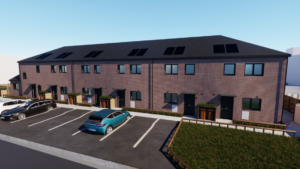Interview: ‘Prefabs’ authors, Elisabeth Blanchet and Sonia Zhuravlyova

Over 150,000 prefabricated homes were built across the country during the post-war period, and a new book published by Historic England explores their history in the UK. Prefabs also includes interviews with the people that lived in them and looks into their various designs and functions.
NewStart spoke to the book’s authors, Elisabeth Blanchet and Sonia Zhuravlyova, about why tenants liked them so much and what role modular housing has to play in the current housing crisis.
Why did so many of the prefabs last longer than predicted?
EB: Because residents really loved them and often petitioned councils to have the homes clad to make them warmer, this is what happened in Catford, Redditch and Ipswich.
This made the prefabs more sturdy and made them a little more permanent.
Why did tenants like them so much?
EB: Many of the prefab residents had arrived from overcrowded homes that they had to share with relatives thanks to bomb damage during the war. There was often no inside toilets and no hot running water, so to find themselves in a detached house with all the mod cons was fantastic, and quickly prefabs became rather aspirational places to live.
Which of the different prefab homes mentioned in the book do you like best and why?
EB: There are two types we like best: the Arcon Mk V because of its three doors, its huge window in the living room, and its slightly pitched roof which makes it distinctive from the others. The other type is the UK100, the American-made prefab that was imported from the US because of its very modern design. Its flat roof was made from Homasote panels (a sort of papier mâché).
How are prefabs viewed today in the USA and Europe?
SZ: I think the building industry is trying to educate customers about the benefits of prefabricated built homes, made from timber, which is a friendly material to both people and the environment. Prefabs have gone through various incarnations in the US, from handy homes built for gold prospectors and new settlers and then GIs after the war to having a bit of a negative or ‘cheap’ image. We can’t really speak for the whole of the US and actually, we’re not really sure what people really think of prefabs there.
Timber-rich countries, such as Canada and in Scandinavia, are much more used to living in wooden and prefabricated houses.
Critics called them ugly, is this fair?
EB: I think they can be for sure, but they don’t need to be. As technology improves, I think prefab houses and buildings will become more intricate and interesting.
The book says modular homes are still associated with post-war austerity, how do you turn these perceptions around?
SZ: Yes, I think generally that’s often the case because prefabrication has come to be seen as something that’s not permanent or perhaps quickly and cheaply made. I think it’s up to the building industry to show us that prefabs are eco-friendly, affordable and nice places to live, not just shipping-container homes, but more along the lines of the Huf Haus, which is a luxury prefabricated home.
There have been various Government pushes towards modular over the past 20 years or so. Is the current Government serious in their statements about building more modular homes?
EB: I think there are regular attempts by different governments to bring back prefabs onto the housing agenda. But I think it’s more now about ‘affordable houses’ for people to buy and not for proper social housing. I also think that nothing is thought in terms of a national social housing scale.
SZ: My general feeling is that every incoming government admits that there is a housing shortage and prefabrication is always touted as the solution for quick and efficient house building. So every four to five years there’s renewed interest in it from the media and people start to look back on its history to see what lessons can be learnt from what’s come before. But really, there hasn’t been the same kind of government-sponsored investment in prefabrication as what happened at the close of the second world war.
You can buy Prefabs here.















